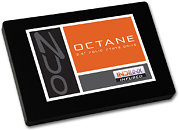- Joined
- Oct 9, 2007
- Messages
- 47,751 (7.42/day)
- Location
- Dublin, Ireland
| System Name | RBMK-1000 |
|---|---|
| Processor | AMD Ryzen 7 5700G |
| Motherboard | Gigabyte B550 AORUS Elite V2 |
| Cooling | DeepCool Gammax L240 V2 |
| Memory | 2x 16GB DDR4-3200 |
| Video Card(s) | Galax RTX 4070 Ti EX |
| Storage | Samsung 990 1TB |
| Display(s) | BenQ 1440p 60 Hz 27-inch |
| Case | Corsair Carbide 100R |
| Audio Device(s) | ASUS SupremeFX S1220A |
| Power Supply | Cooler Master MWE Gold 650W |
| Mouse | ASUS ROG Strix Impact |
| Keyboard | Gamdias Hermes E2 |
| Software | Windows 11 Pro |
OCZ introduced a new high capacity variant of its Octane consumer SSD series, the OCT1-25SAT3-1T. Built in the 2.5-inch form-factor with SATA 6 Gb/s interface, the new Octane variant provides 1 TB of unformatted capacity. Based on the Indilinx Everest processor, the drive packs 25 nm MLC NAND flash, and utilizes 512 MB of DRAM cache. It is rated to provide sequential transfer speeds of up to 460 MB/s (reads), 330 MB/s (writes), with 4K read/write random access performance of up to 24,000 IOPS and 32,000 IOPS, respectively. All modern consumer SSD features are present, including TRIM, NCQ, ECC, and 256-bit AES data-encryption. Slated for mid-May, the Octane 1 TB by OCZ won't exactly be cheap.

View at TechPowerUp Main Site

View at TechPowerUp Main Site



